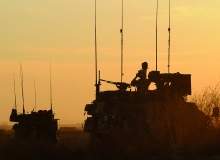
As part of a $5bn plan to revamp the Canadian Army’s armoured vehicle fleet, over $1bn is being spent on upgrading LAV III, the army’s main workhorse, which has seen action in coalition operations around the world, most recently in Afghanistan.
In October 2011, General Dynamics Land Systems was awarded the contract to provide a host of upgrades to Canada’s fleet of 550 LAV IIIs, of which up to a third were out of action due to damage inflicted in Afghanistan. With the first deliveries expected later this year, and the final vehicles planned for 2017, the programme aims to provide troops with improved mobility, firepower, surveillance and protection well into the next decade.
Achieving this aim is not as simple as giving each vehicle a new lick of paint; every LAV will benefit from upgraded armour, weapon systems and surveillance technology. But with each upgrade comes additional weight and power requirements, which could impact the mobility of the vehicle and its effectiveness in theatre.
In all, the upgrade package will add 17,000lb to the vehicle, more than a third of its total weight. This increase comes to a vehicle that when launched was criticised for its susceptibility to rollovers. To counter this, General Dynamics will also make improvements to the powertrain, suspension, running gear and brakes.
Major David Rutkay of the Directorate of Land Requirements, Canadian Army, explains how each upgrade will go towards making the LAV III the armoured vehicle of the future.
Mark Brierley: How will the upgrade programme improve the LAV III’s protection against mines and counter improvised explosive devices (IEDs)?
Major David Rutkay: The Double-V Hull (DVH) technology has been added to improve the overall protection of the LAV III against IEDs and mines.
The DVH design focuses on mine and IED blast protection and, as such, stands on its own. It is not an addition or improvement to vehicle armour. The LAV UP DVH has been thoroughly tested and has met the operational requirements of providing our troops with improved protection and mobility.
Was this addition a direct result of operations in Afghanistan or part of an already-planned upgrade package?
The addition of the DVH is a direct result of both operations in Afghanistan and the planned upgrade package. Lessons learned in Afghanistan have enabled us to enhance an already proven combat vehicle with this new technology. The use of an integrated protected hull improves protection and weighs less than add-on solutions.
What improvements are being made to the firepower and surveillance technology onboard?
In order to successfully operate in different environments and deal with future threats, a new and improved sighting system will be included, which will provide the gunner with better visibility and target identification at a distance of at least 2km.
Will the increased overall weight of the vehicle affect the manoeuvrability of the upgraded LAV?
The new engine and transmission power plant of the upgraded LAV will allow it to perform just as well at 55,000lb as the original LAV did at 38,000lb. By providing a more robust vehicle without sacrificing performance, the LAV UP will ensure improved protection and mobility.
Beyond the inclusion of a more powerful engine, what has been done to mitigate the effect of increased weight?
Further to the more powerful engine, the LAV UP includes a completely new driveline and an improved suspension system to handle the increased weight.
The vehicle has been criticised for its high centre of gravity and perceived susceptibility to rollovers. How has the upgrade addressed this issue?
The Canadian Forces and Department of National Defence have put the LAV III through significant testing, and have proven that terrain, driver error and speed are the predominant causes of rollover scenarios and not the vehicle itself. The LAV UP maintains its 30% side-slope capability.
This programme will extend the life of the LAV III to 2035. How is it possible to plan for future threats so far in the future and incorporate them into the design?
These planned upgrades will allow the Canadian Forces to take advantage of cutting-edge technologies, further reducing the risk to our personnel and limiting casualties.
Based on the most up-to-date threat analyses conducted, the changes made to the LAV design offer the best protection at an affordable price for our military personnel.
This article was first published in our sister publication Defence & Security Systems International.




